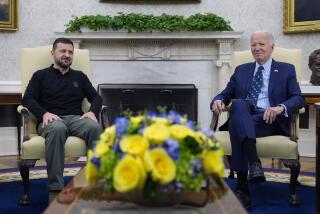Air Force proposes $3-billion plan to vastly expand its drone program
- Share via
Reporting from Washington — The Air Force wants to vastly expand its drone program over the next five years by doubling the number of pilots and deploying them to bases in California and elsewhere to give commanders better intelligence and more firepower.
The $3-billion plan, which must be approved by Congress, was unveiled Thursday after months of study that focused on a drone pilot force that commanders have described as overworked, undermanned and underappreciated.
The proposed expansion comes as the Pentagon has intensified airstrikes on Islamic State targets in Iraq and Syria. Pilots and crews who operate the MQ-1 Predators and MQ-9 Reapers have struggled to meet a rising demand for aerial surveillance of war zones and other hot spots.
NEWSLETTER: Get the day’s top headlines from Times Editor Davan Maharaj >>
“Right now, 100% of the time, when a MQ-1 or MQ-9 crew goes in, all they do is combat,” said Gen. Herbert “Hawk” Carlisle, head of Air Combat Command, which oversees drone operations. “So we really have to build the capacity.”
The Air Force wants to add 75 Reapers to the current fleet of 175 Reapers and 150 Predators. It also would increase the number of flying squadrons from eight to as many as 17, and add up to 3,500 new pilots, sensor operators and other personnel.
Officials said they anticipate sending most of the new drone pilots and crews to bases across the country.
Those considered most likely include Beale Air Force Base near Sacramento, Davis-Monthan Air Force Base near Tucson, Joint Base Pearl Harbor – Hickam near Honolulu, and Langley Air Force Base near Newport News, Va.
Pentagon officials also are considering putting a drone operations center at Lakenheath, a Royal Air Force base in Suffolk, England, but that would require an agreement with British authorities.
Most Air Force drone missions around the world now are run from a single site, Creech Air Force Base, about an hour’s drive from Las Vegas. The 3,325 military and civilian personnel assigned there must commute because no housing facilities exist on base.
The five new drone operations centers would cost about $1.5 billion to build, according to the Air Force. Some 400 to 500 pilots and crew personnel would be assigned to each base, for another $1.5 billion.
The multiple bases could allow drone crews to hand off responsibility for ongoing missions to take advantage of shifting time zones. That would ease the crushing workload at Creech, and reduce stress on the pilots and sensor operators.
“We’ll have a little more stability and pass work back and forth,” Carlisle said.
Chaitra M. Hardison, a RAND Corp. analyst who has studied the psychic toll of remote-control warfare for the Air Force, said it is difficult for pilots to find a balance because they fight foreign wars each shift and return home after work.
“Unfortunately, the shift work and shift rotation may prevent them from engaging in many valued activities during their free time … like attending night school, coaching a sport, sharing in child care, attending sports games and recitals,” she said. “This can impact families and service members’ perceptions of their quality of life.”
As part of the plan, the Air Force hopes to create a more traditional military command structure. The drone program has grown exponentially in the last decade and lacks organization, officials said.
Pilots now operate drones an average of 900 hours a year each, or more than three times more than fighter pilots.
To ease the pressure, Defense Secretary Ashton Carter agreed this summer to reduce the number of daily round-the-clock drone missions, called combat air patrols, from 65 to 60. He also increased monthly bonuses for experienced drone pilots.
See the most-read stories this hour >>
“While horrendous hours may be necessary on a combat deployment, ridiculous schedules are not necessary,” said T. Mark McCurley, a retired pilot who commanded a Predator squadron that targeted high-ranking targets, such as Anwar Awlaki, an American-born recruiter for Al Qaeda in Yemen who was killed by a drone strike in 2011.
Many drone pilots flew bombers, cargo planes and fighter jets before they were reassigned to Predators and Reapers, and many were not happy to make the switch. Recruiting a new generation of pilots is now the priority.
“It’ll take time … for the old guard to work their way out of the system,” said Peter W. Singer, a fellow at the nonpartisan New America Foundation and author of “Wired for War.” “These operations are now the norm, but many still don’t want to face up to that reality and the change that entails. Just the way it goes with disruptive change.”
Follow @wjhenn for military and defense info.
ALSO
FBI says it is refocused on movement of Islamic State recruits into U.S.
ACLU argues the U.S. is dragging its feet on why people are on that ‘no-fly’ list
After terror attacks, Muslim women say headscarves have made them targets for harassment
More to Read
Sign up for Essential California
The most important California stories and recommendations in your inbox every morning.
You may occasionally receive promotional content from the Los Angeles Times.














